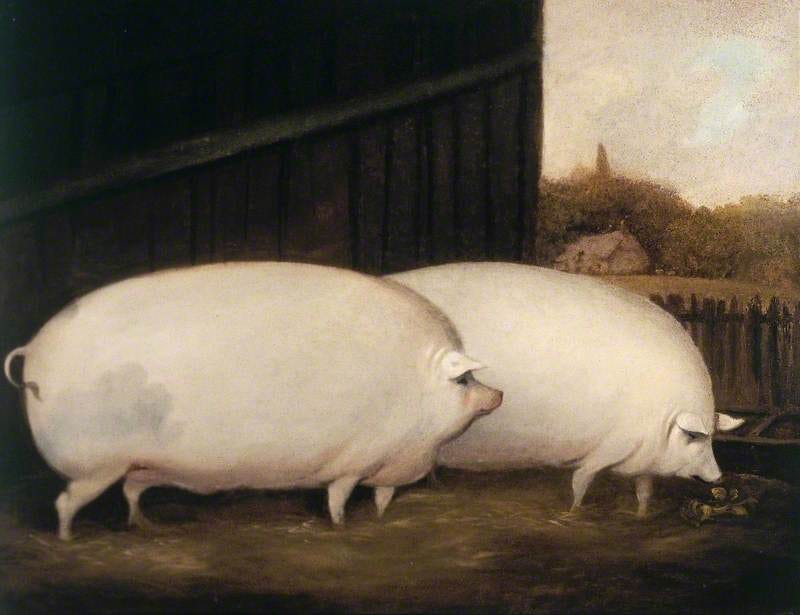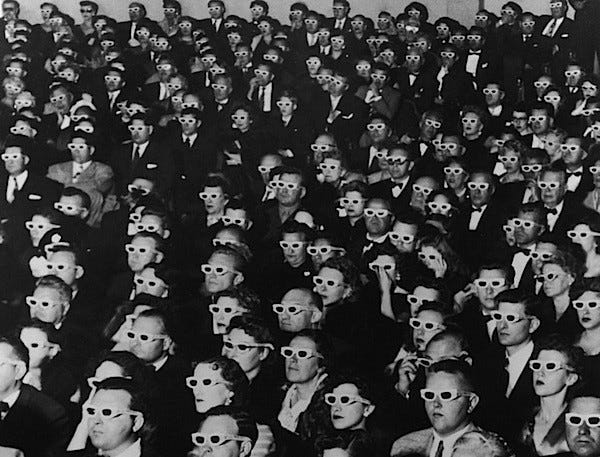Friends!
This week, we’re looking at (toying with, wading through) an internet flooded with low-quality, AI-generated content known as “slop.” Slop is the often discomfiting, occasionally disturbing, content that shows up on your screens in the form of pop-up ads, video reels, and Google's recently-inaugurated “AI Overview” function.
In Stuff for Study, Vitória Oliveira shares essays on how slop perverts language, makes us “weaker, stupider, and less connected,” and threatens to destabilize reality itself. In Visions of Attention, Haena Chu meditates on the culinary habits of 19th century British swine as a historical echo of online trough-feeding. And in From the Trove, David Landes points us to three thinkers — Jean Baudrillard, Guy DeBord, and Jonathan Beller — whose work can help us make sense of this disorienting moment.
Plus: if you're looking to discuss slop with like-minded Attention Activists while supporting SoRA’s non-profit, mission-driven work AND sipping a cocktail swirled by the esteemed mixologists of New York’s Moss, join us THIS THURSDAY, May 15th, for our inaugural benefit party! RSVP at the link — and if you can't make it, feel free to support us from afar.
And at the very least: read on, subscribe, and share with your friends! Let’s have fewer sludge buckets and more Empty Cups (and for those joining us on the 15th, more cups filled with the good stuff)!
Peter Schmidt
Editor-in-Chief
Stuff for Study: Slop Capitalism
Readings and other resources for continued learning on attention and politics
First Came ‘Spam.’ Now, With A.I., We’ve Got ‘Slop’ — Benjamin Hoffman for the New York Times
When AI summaries replace hyperlinks, thought itself is flattened — Collin Jennings for Aeon
AI Slop is a brute force attack on the algorithms that control reality — Jason Koebler for 404 Media
Slop capitalism: towards a unified theory of slop — Aidan Walker on Substack,
How slop is ‘breaking our brains’ — Jia Tolentino for the New Yorker
- Vitória Oliveira
Visions of Attention
An archive of images and mini-essays on the myriad modes of attention
“Bröther, may I have some öats?”

Yeezy sneakers, crocodile skin bags, and Ferraris — before the status symbols of our day, there were… square cattle. The “innovations” in the early 1800s of selective breeding and new feeding practices created a competitive culture of prize cattle among British farm owners. These farmers flaunted their prized possessions in paintings depicting squat, fattened, and almost blocky-looking livestock — or, you might say, pre-packaged units of meat.
A Pair of Pigs is one such painting. Familiar now to many internet users as the meme Bröther, may I have some öats, it was already a “meme” in its time: a typology that propagated and reinforced a certain shared pride amongst breeders. To transform living beings into products — “live” “stock” in the true sense of the word — with unprecedented efficiency, oats became feed and feed became slop, a nebulous substance that eliminates any undue attention to the process of foraging and consuming. It's no surprise that this pair of pigs, almost interchangeable to one another, are so square — they stand as links in a chain of metabolism that links slop to animal, one animal species to another… and at the end, a hazy promise of prosperity.
- Haena Chu
From the Trove
Long-form recommendations from the Friends of Attention’s collaborative Attention Trove archive

Philosophies of AI Slop & Attention as Financialized Sense-Harvesting in Artificial Environments
To make sense of the rising tide of AI-slop, the trove spotlights three touchstone classics. Each offers a vocabulary that equips us to see beyond the surface of AI-generated products and into their less visible social processes and attentional contexts.
Jean Baudrillard, philosopher of Simulacra and Simulation (Video summary and original text), provides a far-reaching vocabulary for a culture increasingly made of simulations, where daily life resembles “a precession of simulacra.”
Guy Debord’s Society of the Spectacle (original video essay and original text) invites us to monitor what forms of power and sociality are occurring through the image. For example, “The Spectacle is not a collection of images, but a social relation among people, mediated by images.”
Jonathan Beller, The Programmable Image of Capital: M-I-C-I′-M′ and the World Computer (Video summary and original text). A political economy of AI slop and the “colonization of our representational systems” (e.g., text, image, sound). Here, attention functions as labor, collected by a “world computer” that converts looking and listening into asset pricing (e.g., ad space, material commodities, media commodities, brand value, etc.). This regime is a distinctive form of capitalist production, the computational mode of production, characterized by the automated integration of culture, attention, and financial processes. Beller further explores this topic in his 2006 book The Cinematic Mode of Production: Attention Economy and the Society of the Spectacle.
- David Landes
IRL
A rundown of what's up at the Strother School of Radical Attention in Brooklyn
Thu, May 15: Want to support SoRA’s nonprofit work? At a fab party? It’s our spring benefit!
Mon, May 19: Meet Your Professors: Summer Faculty Edition
Thu, May 22: Sidewalk Study: Prospect Park
Looking ahead: SoRA’s second annual SUMMER YOUTH ACADEMY runs from June 23-27. To find out more, email strotherschool@sustainedattention.net with the subject line SUMMER ACADEMY.
Find more workshops, events, and gatherings here!




